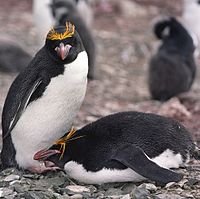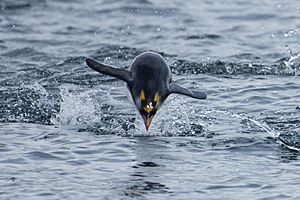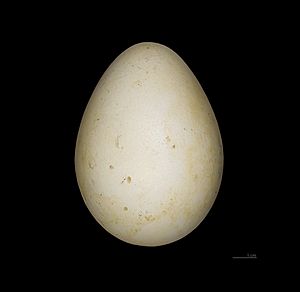Macaroni penguin facts for kids
Quick facts for kids Macaroni penguin |
|
|---|---|
 |
|
| In Cooper Bay, South Georgia | |
| Conservation status | |
| Scientific classification | |
| Genus: |
Eudyptes
|
| Species: |
chrysolophus
|
 |
|
| Macaroni penguin range Breeding colonies in red |
|
| Synonyms | |
|
Catarractes chrysolophus Brandt, 1837 |
|
Macaroni penguins are a type of crested penguin. They get their name from their amazing crests of feathers. These penguins are easy to spot because of their black faces and bright orange-yellow crests. These crests form a band across their foreheads.
Macaroni penguins live on islands near Antarctica. They also live on islands south of Africa and the Americas. They build their nests on cliffs and hillsides.
Contents
What Macaroni Penguins Look Like
The macaroni penguin is a large penguin. It looks a lot like other penguins in its family, Eudyptes. An adult penguin is about 70 cm (28 in) long. Their weight changes a lot depending on the time of year and if they are male or female.
Males can weigh from 3.3 kg (7 lb) after taking care of eggs to 6.4 kg (14 lb) before they lose their feathers. Females weigh from 3.2 kg (7 lb) to 5.7 kg (13 lb). Their thick bill is about 7 to 8 cm (2.8 to 3.1 in) long.
Their head, chin, throat, and upper body are black. Their belly is white. The black feathers look bluish when new and brownish when old. The most special thing about them is their yellow crest. It starts on their forehead and goes back to their neck.
Their flippers are blue-black on top with a white edge. Underneath, they are mostly white with a black tip. Their large, round bill is orange-brown. Their eyes are red. They have a pink patch of skin from their bill to their eye. Their legs and feet are pink.
Males and females look very similar. Males are usually a bit bigger. Males also have bigger bills, about 6.1 cm (2.4 in) long, while females' bills are about 5.4 cm (2.1 in). This difference helps tell them apart.
Young macaroni penguins are smaller. They have duller brown bills and dark grey chins and throats. Their head crests are missing or not fully grown. They might just have a few yellow feathers. The crest grows fully when they are three or four years old. This is usually a year or two before they start breeding.
Moulting: Changing Feathers
Macaroni penguins moult once a year. This means they replace all their old feathers. Before moulting, they spend about two weeks eating a lot to gain fat. They do not eat during the moult. This is because they cannot go into the water to find food without their feathers.
The moulting process takes about three to four weeks. During this time, they stay on land. After they finish moulting, they go back to the sea. Then they return to their colonies to find a mate in the spring.
Where Macaroni Penguins Live
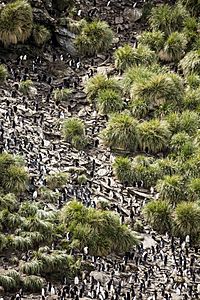
Macaroni penguins are one of the most common penguin species. In 1993, it was thought there were at least 11.8 million pairs worldwide. They live from the Subantarctic regions all the way to the Antarctic Peninsula. Over 216 breeding colonies have been found in 50 different places.
In South America, you can find macaroni penguins in southern Chile, the Falkland Islands, South Georgia and the South Sandwich Islands, and the South Orkney Islands. They also live in many parts of Antarctica. This includes the northern South Shetland Islands, Bouvet Island, the Prince Edward and Marion Islands, the Crozet Islands, the Kerguelen Islands, and the Heard and McDonald Islands.
When they go out to find food, groups of penguins can travel north. They visit islands off Australia, New Zealand, southern Brazil, Tristan da Cunha, and South Africa.
Protecting Macaroni Penguins
The total number of adult macaroni penguins is about 18 million. However, their numbers have dropped a lot in many places. For example, the population in South Georgia fell by 50% from the mid-1970s to the mid-1990s. They have also disappeared from Isla Recalada in Southern Chile.
Because of this decline over the last 30 years, the IUCN Red List of Threatened Species has listed them as "globally Vulnerable". This means they are at risk of becoming endangered. Scientists are watching many breeding colonies to keep track of their numbers. Many islands where these penguins live are protected areas. The Heard Islands and McDonald Islands are even World Heritage Sites for the macaroni penguin.
Macaroni penguins might be affected by commercial fishing and ocean pollution. A study in 2008 suggested that female penguins might have trouble having babies. This could be due to less krill (their main food) because of climate change and fishing.
Macaroni Penguin Life
Macaroni penguins are very social animals. They live in large, crowded colonies when they nest and when they look for food. Their breeding colonies are some of the biggest and most packed.
Scientists have found that macaroni penguins from Kerguelen travel very far east. They can cover an area larger than 3 million square kilometers. Some penguins with tracking devices traveled over 10,000 km (6,200 mi) in six to seven months. They spent most of their time in a certain area of the central Indian Ocean. They did not come ashore during this time. This area is called the Polar Frontal Zone. It is known for not having much krill.
Living in colonies means penguins interact a lot. They have many ways to show how they feel, using both body language and sounds. These behaviors are most common early in the breeding season. Colonies become much quieter when the male penguins are out at sea.
Penguins also have ways to deal with conflict. They might 'bill-joust,' where they lock bills and wrestle. They also hit each other with their flippers or peck at their opponent's neck. To show they are not looking for a fight, they might do a 'slender walk.' They move through the colony with their feathers flat, flippers forward, and head and neck hunched. They also hunch their head and neck when sitting on a nest.
Who Hunts Macaroni Penguins?
The macaroni penguin has predators both in the air and in the water. In the water, adult macaroni penguins are hunted by leopard seals, Antarctic fur seals, Subantarctic fur seals, and killer whales.
On land, colonies usually do not have many predators if they are left alone. Predators mostly take eggs and chicks that are left alone or abandoned. Skuas, snowy sheathbills, and kelp gulls eat eggs. Skuas and giant petrels also eat chicks and sick or injured adult birds.
Reproduction and Raising Chicks
Adult macaroni penguins usually start breeding in late October. They lay their eggs in early November. Their nest is a shallow scrape (a small dip) in the ground. They might line it with pebbles, stones, or grass. Sometimes, they nest in clumps of tussock grass. Nests are very close together, about 66 cm apart in the middle of a colony.
A female macaroni penguin will lay two eggs each breeding season. The first egg is smaller, weighing about 90–94 g (3.2–3.3 oz). The second egg is much larger, weighing about 145–155 g (5.1–5.5 oz). The first egg almost never survives. Both eggs together weigh about 4.8% of the mother's body weight. Penguin eggshells are quite thick to prevent breaking. The yolk is large, which means chicks are born quite developed. Some yolk stays in the chick after hatching and feeds it for the first few days.
The first egg often does not make it. Studies on similar penguins show that the female often pushes the first egg out when the larger second egg is laid. The parents share the job of incubating (keeping warm) the egg. They take turns in three sessions, each about 12 days long, over five weeks. Both parents share the first session. Then the male goes to sea, leaving the female alone with the egg. When the male returns, the female goes to sea and does not come back until the chick hatches.
Both parents go without food for a long time during breeding. The male fasts for 37 days after arriving. Then he goes to sea for about 10 days. He fasts again for another 36 days while taking care of the eggs and young. The female fasts for 42 days from her arrival until late in the incubation period. Both adults lose a lot of weight, about 36–40%, during this time. The second egg hatches about 34 days after it is laid. Macaroni penguins usually leave their breeding colony by April or May to go out into the ocean.
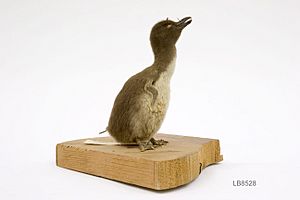
Once the egg hatches, the male macaroni penguin takes care of the new chick. For about 23 to 25 days, the male protects the chick and keeps it warm. This is because the chick only has a few feathers at this time. The female brings food to the chick every one to two days.
When they are not being protected by the adult male penguins, the chicks gather together. They form groups called crèches to stay warm and safe. When their adult feathers have grown in, at about 60 to 70 days old, they are ready to go to sea on their own.
What Macaroni Penguins Eat
Macaroni penguins eat different kinds of crustaceans, squid, and fish. What they eat most depends on where they are and the time of year. During breeding season, Antarctic krill makes up over 90% of their food. Squid and small fish become more important when they are raising chicks. These fish include the marbled rockcod, painted notie, and lanternfish species.
Like some other penguins, macaroni penguins sometimes swallow small stones. Scientists think this might help them dive deeper. It could also help them grind up their food, especially the hard outer shells of crustaceans.
Penguins usually look for food every day, from morning until night, when they have chicks to feed. Sometimes, they make overnight trips, especially as the chicks get older. A study in 2008 showed that their foraging trips get longer after the chicks are grown. Before moulting and during incubation, birds go out for 10–20 days. Macaroni penguins are thought to eat more marine resources than any other seabird. They are estimated to eat 9.2 million tonnes of krill each year.
Outside the breeding season, macaroni penguins tend to dive deeper and for longer. They are also more efficient at finding food during their winter travels. All year round, they usually dive for food during daylight hours. But winter dives are more limited by the shorter days.
The distance they travel from their colonies to find food varies. At South Georgia, it's about 50 km (31 mi) over the continental shelf. At Marion Island, it can be anywhere from 59 to 303 kilometres (37 to 188 mi). Macaroni penguins usually dive to depths of 15 to 70 m (49 to 230 ft). But they have been recorded diving down to 100 m (330 ft) sometimes. They do some night foraging, but these dives are much shallower, only 3 to 6 m (9.8 to 19.7 ft) deep. Dives rarely last longer than two minutes. All their dives are V-shaped, meaning they do not spend time at the bottom of the sea. About half the time on a foraging trip is spent diving. It's estimated that birds catch from 4 to 16 krill or 40 to 50 amphipods per dive.
Images for kids
-
A skeleton on display in Manchester Museum
See also
 In Spanish: Pingüino macaroni para niños
In Spanish: Pingüino macaroni para niños




